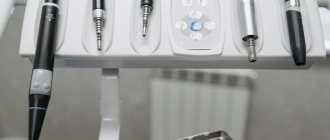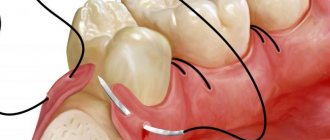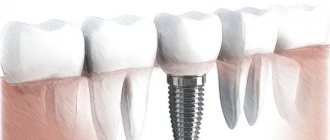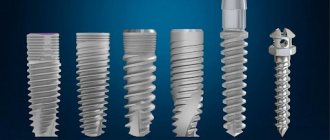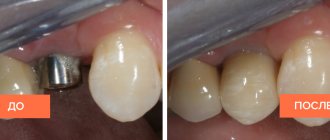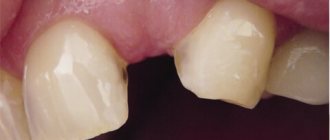All patients strive to spend as little time as possible in the dentist's chair, regardless of what manipulations the doctor performs. But, if we are talking about such an operation as the introduction of an artificial root into the jawbone, questions about the timing are asked especially often. Many people, even at the initial consultation stage, are interested in how long it takes to place a dental implant, believing that such a procedure lasts a long time.
Before answering this question, let us briefly dwell on the actions that a dental surgeon performs during such an intervention.
How long does it take to insert a tooth?
The duration of the tooth restoration procedure depends on the restoration method. If the tooth is destroyed by no more than 1/3 and has a intact root, it can be restored directly in the patient’s mouth in one visit. If the root is preserved and the crown part of the tooth is destroyed by more than 1/3, you can resort to microprosthetics, which is also performed in one visit.
If the coronal part is significantly destroyed and the tooth must be removed, implantation or installation of a bridge structure supported by adjacent teeth is indicated. If the patient chooses implantation, then modern protocols make it possible to restore the integrity of the jaw row in one or two visits. The traditional protocol involves allowing the implant to heal for about six months and, if osseointegration is successful, installing a permanent crown.
Priorities of specialists at the ALTEYDENT clinic
In our work, we give preference to the safety of procedures and the long service life of installed implants. Therefore, we choose classic protocols for installing artificial roots. Despite the fact that the direction of one-stage restorations using basal structures is successfully developing, it still demonstrates a higher probability of implant failure.
In addition, the ability of basal implants to evenly transfer the load to the jaw is realized only when a significant number of artificial roots are installed (at least 4 - 6). Root implants have a wide range of parameters, so with their help it is much easier to choose the best option for any individual situation, be it replacing one tooth or an entire row of teeth.
If it is critical for the patient to minimize the duration of restoration with implants, we use AnyRidge mini-root systems. Temporary crowns, suitable for chewing and quite acceptable in aesthetic terms, can be fixed with this technology already on the 4th - 5th day. The only limitation is that before replacing temporary dentures with permanent ones (after 2 months), the patient must observe moderation in eating solid foods.
How does the second stage of dental implantation proceed?
The second stage of dental implantation is marked by the installation of a gum former. The purpose of the implant system element is to create a beautiful contour of the gum line. With one-stage implantation, the former is installed immediately after implantation. The construction is removed at the second visit and replaced with a temporary crown on the abutment. With a traditional two-stage protocol, the former is installed only after 4-6 months, when the implant has successfully taken root. In this case, a second operation is performed, during which the gingival flap is excised, the plug is removed from the implant, the former is fixed, and the wound is sutured tightly.
What manipulations are performed when installing an implant?
The main steps when using the classical technique:
- Introduction of an anesthetic drug.
- Cutting the gums and peeling off the mucoperiosteal flap.
- Formation of the bone bed, with its gradual expansion until the desired size is achieved.
- Periodic irrigation of tissues to prevent overheating of the bone.
- Screwing a metal implant into the hole and installing a plug.
- Placement of mucoperiosteal flaps and suturing.
How long can you wear implants without crowns?
If we consider a two-stage implantation protocol, then you will have to walk without permanent crowns for six months. To restore the aesthetics and chewing function of the dental system, temporary plastic crowns are fixed 2-3 months after surgery.
Permanent crowns are installed only after successful osseointegration of the implant into the bone tissue. Temporary crowns should be worn not only for aesthetics, but also to prevent atrophy of the bone tissue of the jaw arch and destabilization of the titanium rod.
Choosing where to get treatment
You can choose a dental clinic based on price level, but you just need to make sure that they can help you there. Sometimes it happens that someone’s teeth were inserted poorly, after which complications arose or the result turned out to be unaesthetic. Typically, such patients leave unflattering reviews about a medical institution or a specific doctor. They also write where they went next, and where they managed to fix everything. However, you should not completely rely on these reviews. After all, if a person writes and does not know what kind of doctor he is who inserts teeth, what his specialty is called, then is it worth trusting such assessments? Anyone who actually underwent treatment knows for sure that he consulted an orthopedist or orthodontist, that the prosthesis was made by a dental technician - and this is a different specialist, and that the preparatory work was done by a dental therapist. In small clinics, a doctor can combine the work of an orthopedist and a therapist, but never also act as a dental technician!
So it’s always better to rely on the choice of your friends rather than on the opinion of a stranger who left a review on the site. Such a person could be hired by competitors to ruin the reputation of the dental clinic.
What happens if the implant does not take root?
Implant failure is difficult to prevent. The causes of the pathology may be peri-implantitis, smoking, non-compliance with medical recommendations in the early and late postoperative period. If acute rejection occurs, removal of the titanium rod is indicated. Re-implantation is possible only after complete healing of the wound. Rejection can develop several years after the permanent crown is installed. A number of external and internal factors can provoke a pathological process and destabilization of the implant.
Read also
Types of implants
If you look at the recent past, people had to put up with the fact that it was necessary to remove a diseased tooth and so on...
Contraindications to dental implantation
Our clinic provides effective treatment, extraction and implantation of teeth…
Preliminary consultation
This stage is mandatory and is carried out in order to ensure high-quality dentures. A preliminary consultation helps the patient understand the many questions he has and allows him to correctly plan the upcoming prosthetics.
The procedure takes no more than 30-40 minutes. During the initial appointment, the dentist carries out the following actions:
- Oral examination, in which the condition of the mucous membrane, teeth, the quality of oral hygiene, the functionality of the masticatory muscles, the mandibular temporal joint, and the patient’s posture are assessed.
Attention is also paid to the condition of existing fillings and the need to replace them is determined.The installed prosthetic structures (if any) are inspected, the degree of sensitivity of the teeth is checked, signs of dental diseases are identified and the stages of their development are determined, the issue of the need for preliminary treatment is resolved.
- Interview and anamnesis collection . Informing about all types of upcoming work, features of preparation for prosthetics, type of anesthesia, progress of the operation, priority and sequence of all manipulations.
- Selection of the most optimal type of prosthetics , material of the prosthesis, method of its fastening.
- Drawing up a preliminary plan for subsequent actions, taking into account the complexity of the clinical case. Clarification of the price of the work, as well as deadlines.
If necessary (if the clinic is complex), consultations with highly specialized specialists are prescribed - a dental surgeon, orthodontist, therapist, periodontist.
Each of the doctors, taking into account the specifics of their specialty, will indicate the possible presence of hidden problems and recommend the optimal solution to the problem of missing teeth. Joint actions of doctors will allow you to accurately plan treatment, prevent complications and ensure high-quality results.
Indications for installation of a soldered prosthesis and design features.
Come here to take a closer look at composite bridges.
At this address https://www.vash-dentist.ru/protezirovanie/nesemnyie-p/problem-s-zubami-v-heyhe.html we’ll talk about the price of dental prosthetics in Heihe.
Handling Problem Units
Dental prosthetics involves mandatory processing (preparation) and depulpation.
Grinding is the grinding down of hard dental tissues to achieve a smooth and perfectly even surface. After all, it is precisely this surface that is an important condition for ensuring high-quality fastening of most types of prostheses.
In addition, the teeth are given a shape that exactly replicates the internal cavity of the prosthetic structure, which allows it to be more tightly and accurately secured.
Today, thanks to effective anesthetics and new equipment, preparation is faster (10 minutes is enough for one dental unit) and painless than several years ago.
In practice, teeth grinding can be carried out using one of the following methods:
- Tunneling is a classic technique using a drill with a metal or diamond tip, thanks to which the doctor can grind off any amount of tissue.
- Ultrasonic .
It involves the use of a special apparatus that is capable of transmitting high-frequency vibrations. The tip of the device does not come into contact with the enamel coating, which reduces the risk of accidental damage to the nerve and dentin. Ultrasonic grinding can only remove a small amount of tissue. - Laser . This technique is non-contact and allows you to get the desired result in the shortest possible time. Use is only possible for preparing thin tissues.
- Air-abrasive . The impact on dental tissue occurs using a mixture of water and abrasive particles. The technique is preferable because it eliminates the formation of chips and cracks, and also helps preserve healthy tissue.
- Chemical _
Here the specialist resorts to the help of acids, which are guaranteed to quickly destroy hard tissue. At the end of the process, the softened tissues are removed, and the tooth is given the desired parameters. Chemical preparation is a lengthy procedure (it takes at least 15 minutes to process one element), which is why it is used extremely rarely.
In isolated cases (approximately 10%), tooth depulpation is also performed before prosthetics - this is when inflamed pulp tissue is removed from its root canals.
The procedure takes about 7-10 minutes, is performed under local anesthesia, and only for medical reasons:
- partial exposure of the nerve;
- anatomically incorrect position of the prosthetic element;
- high degree of smoothness of the chewing surface or coronal part;
- mechanical injury, in which there is a high probability of nerve death.
The decision to depulpate the unit being restored is also influenced by the condition of the gums and jawbone, the angle of inclination of the tooth and its position in the row, the volume of the pulp chamber and the type of prosthesis being installed.
Typically, the procedure is carried out before installing metal-ceramic and zirconium crowns, since with this type of prosthetics the pulp becomes more vulnerable due to the removal of a thick layer of hard tissue (2-2.5 mm).
Contraindications
- Early childhood and adolescence
- Blood diseases in which clotting is impaired
- Severe uncontrolled diabetes mellitus
- Advanced tuberculosis
- Severe osteoporosis
- Serious endocrine disorders
- Oncological processes in the acute stage
- Intolerance to anesthetic drugs
- Serious central nervous system disorders
- Chronic alcoholism, drug addiction
- The patient does not follow the recommendations for care
Temporary contraindications to surgical intervention are the unsatisfactory condition of the gums and enamel, pregnancy, periods of exacerbation of chronic diseases, colds and flu.
Thanks to the development of technology, the installation of dental implants has become available to patients with hepatitis and diabetes, and people with reduced immunity. When using low-traumatic techniques, the procedure is allowed for elderly patients.
How durable are teeth in 1 day?
The service life of implants using the all-on-4 or all-on-6 method is 15-20 years. With good hygiene and regular visits to the dentist for checkups, these implants can last a lifetime.
They do not require special care. Regular brushing of teeth 2 times a day and rinsing the mouth is sufficient.
Typically, implant manufacturers provide a temporary or lifetime warranty on their products. In addition, some dentists provide a guarantee on their work. Therefore, if, with proper care and regular checks, problems arise, you will not have to pay to fix them.
Taking an impression
To achieve a comfortable and tight fit of the prosthesis, as well as ensure proper closure of the jaw arches, the prosthetic design must precisely correspond to the topographic and anatomical specificity of the patient’s oral cavity. For this purpose, an impression is taken from teeth already prepared for prosthetics.
An impression (otherwise known as a cast) in dentistry is the reproduction of the contours of soft tissues, ground and healthy teeth, alveolar cords, palatal transverse suture, and frenulum on impression material.
Important! Without a cast, it is impossible to correctly make a plaster model and make a structure that is optimal in all respects.
Taking into account the clinic and the type of prosthesis chosen, the following groups of materials can be used for the impression:
- elastic;
- hard;
- polyester;
- thermoplastic;
- modeling.
To take an impression, the doctor fills an impression tray with material, inserts it into the patient’s mouth, and places it on the teeth so that they are completely covered in the impression material.
The hardening of the material lasts about 20-25 minutes, after which the spoon is carefully removed, the impression is taken, washed with running water, disinfected and transferred to the laboratory.
Rehabilitation
Often people tolerate surgery easily. The very next day they go to work and return to business as usual.
After the installation of a dental implant, a rehabilitation period begins. It depends on the treatment protocol and ranges from several days to two weeks.
Swelling, pain, and slight bleeding immediately after the procedure are considered normal. To eliminate them, cold compresses on the cheek and anesthetics are recommended. 2-3 days after the installation of a dental implant, bruises appear on the face - a consequence of vascular injury, this is a normal option. To restore tissue, use gels to resolve bruises.
After installation of the prosthesis, you may experience discomfort while eating and talking. The adaptation period lasts 3-4 days. If you have difficulties with diction, train the articulation of sounds using tongue twisters and reading aloud. During training, keep several sugar-free lollipops in your mouth and pronounce each word clearly.
Seeing a doctor after surgery is required if:
- after 2-3 hours bleeding from the gums continues or intensifies;
- on the third day after surgery, the pain did not go away or intensified;
- numbness does not go away and spreads throughout the face;
- on the 2-3rd day severe swelling appeared;
- the temperature jumped sharply, hyperthermia persists for 3-4 days after root implantation;
- sharp pain occurs when pressing on the implant area after a week;
- there was a divergence of the seams;
- after attaching the temporary crown, the teeth do not close together and it is difficult to chew;
- mobility of the prosthesis is noted.
Fitting and correction
The finished prosthetic structure requires mandatory fitting before installation. The use of high-precision equipment in the process of its creation will not provide a 100% guarantee that the orthopedic product is absolutely identical to the characteristics of the client’s dentofacial apparatus.
Fitting lasts about 20 minutes. During this procedure, the doctor marks areas that require additional grinding or reducing the surface thickness.
Based on the amount of work required to fit the structure, it may take from 2 to 4 hours to adjust its parameters.
Important! Above is the time for fitting and finalizing one prosthesis. When there are several of them (for example, they are single), or it is a large bridge, the fitting and adjustment period increases accordingly.
Fixation process
For the final installation of the orthopedic structure, the patient needs to spend 40-60 minutes in the dental chair. At that time:
- the prepared dental element is treated with an antiseptic;
- the oral cavity is dried out;
- a composition that increases adhesion is applied to the abutment tooth;
- The crown is placed on dental cement.
After this, you will have to spend another 30-40 minutes with an orthopedic dentist so that the specialist can assess the quality of pronunciation, degree of comfort and other categories indicating the correct installation of the prosthesis or the need for another adjustment, but on the installed structure.
Important! The correction can still be performed several times, i.e. until the desired result is achieved, which prolongs the period of prosthetics.
In the video, the specialist explains what needs to be done first for dental prosthetics.
Recommendations after surgery
In the postoperative period, the patient must follow the doctor’s recommendations:
- You should not eat food for three hours after the procedure. Then warm soup or yogurt, soft cottage cheese, and mashed boiled vegetables are recommended.
- For the first three days, too cold or hot food is recommended. The diet must be expanded gradually. Hard foods create stress when chewing and should be temporarily avoided.
- While eating, try to minimize the mechanical impact on the wound area, give up the habit of chewing a pencil.
- Replace coffee and black tea with herbal or fruit compote.
- Avoid smoking, alcohol, and heavy physical activity.
- The diet should include a sufficient amount of fluid and foods rich in calcium, vitamins P and C.
- To reduce swelling, use cold compresses on the cheek or ice, wrapped in a towel.
- Painkillers prescribed by your doctor will help eliminate the discomfort.
What to do to prevent rejection:
To prevent peri-implantitis, take proper care of your oral cavity and take antibiotics for seven days. Do not touch the seam area with your hands or tongue! For up to 3-4 days after the procedure, you need to make oral baths with an antiseptic solution. When the swelling decreases, it is recommended to rinse your mouth gently. Start brushing your teeth no earlier than the fifth day after surgery. Use the paste to prevent gum inflammation. Please note: it is better to use a new brush with soft bristles!
During the rehabilitation period, avoid sports training, sauna visits, overheating and hypothermia, and air travel. If the procedure was performed using a sinus lift, you should cough and sneeze with caution. You can’t puff out your cheeks too much or open your mouth wide.


